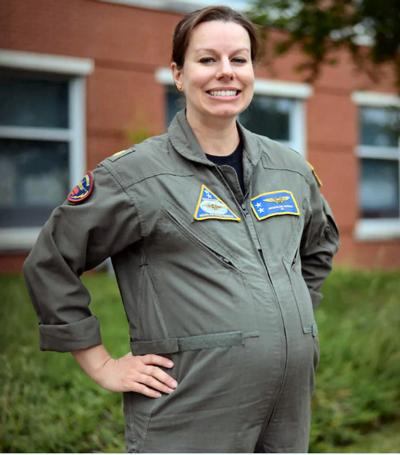Flight Suit Prototypes Designed To Increase Safety, Meet Urgent Fleet Need
In response to an urgent fleet need, the Aircrew Systems Program Office (PMA-202), with the assistance of an in-house tailor, recently began modifying and testing standard flight suits to create a prototype Maternity Flight Suit Uniform (MFSU), and has begun rolling them out to the fleet in a timeframe of less than four months from requirement to fielding.

The program office began alterations to standard flight suits by sewing in expandable panels that provide extra room in the abdomen area where pregnant aircrew need it the most.
Prior to the MFSU, pregnant aircrew had the choice of wearing maternity khaki uniforms or larger-sized flight suits throughout their pregnancies. Wearing larger flight suits resulted in longer hems and sleeves, and, if not tailored for length, these longer lengths presented safety hazards. Additionally, wearing increasingly larger flight suits without tailoring has the potential to present a less professional appearance.
The ultimate goal is to have each flight suit custom-tailored upon request. The program office is building up a “pool” of sizes that could be sent out, which the program office worked in tandem with drafting the ordering procedures and Aircrew Systems Advisory (ASA) naval message. If the program office receives a request for a size that is not in stock, the tailor can shift to work on that specific size in real time.
“We are proud to say the prototype MFSUs are available now,” said Scott Adley, Fleet Support team lead. “Even though they are custom orders, we are capable of filling orders in approximately three days. We released the ASA procedures for ordering to the Fleet, and once initial measurements are made at the command, the request chit is reviewed and then a custom flight suit is made and sent the command.”
The new MFSUs are fitted to aircrew height, preventing rolled up sleeves or cuffed/stuffed flight suit leg lengths associated with wearing larger conventional flight suits. Each MFSU has adjustable side panels made of the same material as the rest of the flight suit with hook adjusters, to provide not only more comfort but also improve safety and allow female aircrew a customizable fit. A single adjustable flight suit can expand across multiple trimesters depending on each pregnancy, saving pregnant aircrew the added expense associated with purchasing multiple flight suits as well as tailoring larger-sized flight suits historically purchased to accommodate the changing pregnant form.
“The team supporting the MFSU development and distribution deserves all the credit for being able to work the drafting and coordination of procedures for ordering and distribution in parallel with the design of the uniform. They continue to provide superior support to the warfighter every day,” said Capt. Tom Heck, PMA-202 program manager.
The Aircrew Systems program office serves as the premiere organization for human performance optimization and enables the Navy and Marine Corps to be combat effective by providing and sustaining Aircrew Systems that work the first time, every time.
 ANN's Daily Aero-Linx (05.02.24)
ANN's Daily Aero-Linx (05.02.24) ANN's Daily Aero-Term (05.02.24): Touchdown Zone Lighting
ANN's Daily Aero-Term (05.02.24): Touchdown Zone Lighting Aero-News: Quote of the Day (05.02.24)
Aero-News: Quote of the Day (05.02.24) ANN FAQ: Contributing To Aero-TV
ANN FAQ: Contributing To Aero-TV NTSB Final Report: Cirrus Design Corp SR20
NTSB Final Report: Cirrus Design Corp SR20



